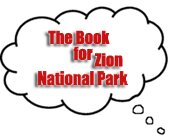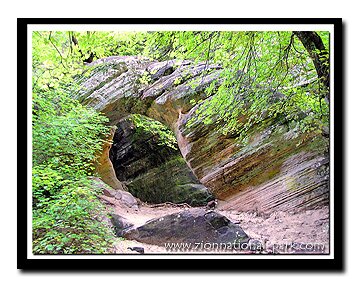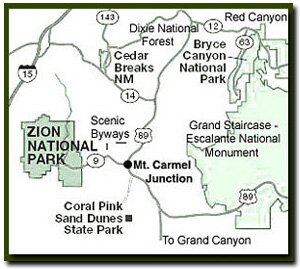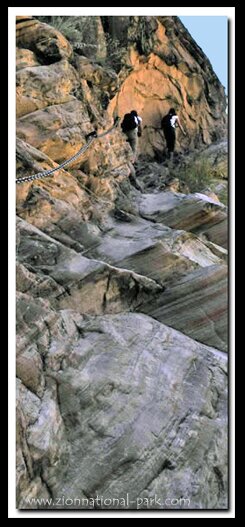
|
||||
|
Zion National Park Lodging Park Info Vacation Weather Photos Hike SR-9 Slots Backpack Camping |
||||
Hidden Canyon
|
|||||||||||||
Directions to Zion National ParkFrom the North: Travel I-15 south, past Beaver. exit on Hwy 20. Follow US-89 to Mount Carmel Junction. Take SR-9 to Zion's east entrance.
|
|||
|
|
|||
![]() There is a sign here directing hikers to stay to the left. The trail will go downhill now as granaries and the Virgin River are in view far below. Moss and lichens cover the large rock to the left in the cool crevice as the trail goes uphill once again. Many sections along the switchbacks are narrow paths with long cliff-side drop offs. Chains are anchored along the worst of it. Sandstone pools at the end of this hike are a favorite spot of canyon tree frogs. Look for the tiny gray creatures near the water and listen for their loud trilling. Past the pools is a sign stating that this is the end of the Hidden Canyon Trail. A short path that requires bouldering does continue for another half-mile past the trail end. A small free standing arch is located near the canyon back. Directly across from the arch is a flat wall adorned in moss – called the Green Wall. Past this point the trail becomes technical. The climb will lead out of the canyon to the upper east plateau. The second freestanding arch in Hidden Canyon is near the top where only a few skilled canyoneers and climbers have tread. Turn around when the hike becomes difficult. On the trek back down into Zion Canyon, note the antique cable draw on Cable Mountain as well as the intoxicating view including Big Bend, Angels Landing, Cathedral Mountain and the Organ.
There is a sign here directing hikers to stay to the left. The trail will go downhill now as granaries and the Virgin River are in view far below. Moss and lichens cover the large rock to the left in the cool crevice as the trail goes uphill once again. Many sections along the switchbacks are narrow paths with long cliff-side drop offs. Chains are anchored along the worst of it. Sandstone pools at the end of this hike are a favorite spot of canyon tree frogs. Look for the tiny gray creatures near the water and listen for their loud trilling. Past the pools is a sign stating that this is the end of the Hidden Canyon Trail. A short path that requires bouldering does continue for another half-mile past the trail end. A small free standing arch is located near the canyon back. Directly across from the arch is a flat wall adorned in moss – called the Green Wall. Past this point the trail becomes technical. The climb will lead out of the canyon to the upper east plateau. The second freestanding arch in Hidden Canyon is near the top where only a few skilled canyoneers and climbers have tread. Turn around when the hike becomes difficult. On the trek back down into Zion Canyon, note the antique cable draw on Cable Mountain as well as the intoxicating view including Big Bend, Angels Landing, Cathedral Mountain and the Organ.
Trail History - On June 27th, 1927, a climber named Evans fell while climbing the Great White Throne Rescuer discovered Hidden Canyon during his rescue. Hidden Canyon was placed on the list of Historic Places on February 14th, 1987.
Optional Side Hikes - The trail will split, going one way to Hidden Canyon and the other to the East Rim and Observation Point. Observation Point is an 8 mile round-trip trail that is probably the most strenuous "classic hike" in the park. The East Rim Trail is better hiked in the opposite direction, ending where the Hidden Canyon trail begins. If hiked this direction then Hidden Canyon is a nice side trip. Middle Echo Canyon is also interesting. Echo Canyon Non-technical Echo Canyon
Beta: Coordinates and other trail and canyoneering information by Zion Park search and rescue veteran team member Bo Beck and zionnational-park.com author Mary Cisneros.
To post trip reports, offer corrections, updates, or for more information please visit the Zion National Park Forum
Suggested Gear: A sturdy pair of shoes are recommend to hike the trails in Zion National Park. Many quality shoes will help grip the rocks and prevent injury.
|
|
Zion National Park, Utah
History of the Thunderbird
East Zion Lodge
Vacation House
Group Lodging
East Zion Golf
East Zion RV Park
Vacation Packages
Mileage from
Mt. Carmel Jct.
Zion National Park 12
Bryce Canyon 60
Grand Canyon 85
Cedar Breaks 45
Grand Staircase 9
Dixie Forest 22
Sand Dunes 11
Coyote Butte 57
Red Canyon 47
Tuweep 90
Stay in a hotel the heart of the parks, Mount Carmel Junction, and visit the treasures of the Southwest and Utah.
Site Map
Site Map II
Site Map III
Zion Hiking
Zion Park Hiking
Zion Hiking Advanced
Zion Canyoneering
Kolob Hiking
Greater Zion Area
|
|
"I don't know who Mary Cisneros is, but I mean zionnational-park.com
It's a better site than the NPS's anyway."
Written by the authors of the book: Favorite Hikes in and around Zion National Park
|
Zion History |
|---|
All rights reserved © Copyright Zion National-Park dot com
Do not use text, photos or maps without permission © Zion National-Park dot com
Contact the Author Mary Cisneros with any errors







